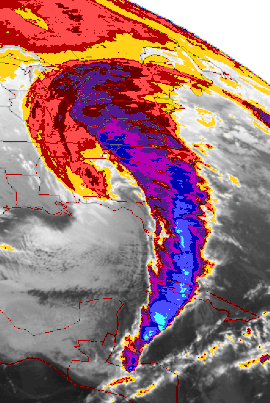1993 North American Storm Complex
| Category 5 "Extreme" (RSI: 24.433) | |

|
|
| Type | Superstorm Extratropical cyclone Nor'easter Blizzard Tornado outbreak |
|---|---|
| Formed | March 12, 1993 |
| Dissipated | March 15, 1993 |
| Lowest pressure | 960 mb (28.35 inHg) |
| Lowest temperature | −12 °F (−24 °C) |
| Tornadoes confirmed | 11 on March 13 (all in Florida) |
| Max rating1 | F2 tornado |
| Duration of tornado outbreak2 | 2 hours, 32 minutes |
| Maximum snowfall or ice accretion | 69 in (180 cm) – Mt. Le Conte, TN |
| Damage | >$2 billion (1993 USD) |
| Casualties | 318 fatalities |
| Areas affected | East Coast of the United States, Canada, Mexico, Cuba |
|
1Most severe tornado damage; see Fujita scale 2Time from first tornado to last tornado Part of the 1992–93 North American winter storms |
|
|
Snowstorm Totals Totals are for the main system only. |
|
|---|---|
| Snowshoe, WV | 44 in (110 cm) |
| Syracuse, NY | 43 in (110 cm) |
| Tobyhanna, PA | 42 in (110 cm) |
| Lincoln, NH | 35 in (89 cm) |
| Blairsville, GA | 35 in (89 cm) |
| Boone, NC | 33 in (84 cm) |
| Gatlinburg, TN | 30 in (76 cm) |
| Pittsburgh, PA | 25.2 in (64 cm) |
| Chattanooga, TN | 23 in (58 cm) |
| London, KY | 22 in (56 cm) |
| Worcester, MA | 20.1 in (51 cm) |
| Ottawa, ON | 17.7 in (45 cm) |
| Birmingham, AL | 13 in (33 cm) |
| Montreal, QC | 16.1 in (41 cm) |
| Trenton, NJ | 14.8 in (38 cm) |
| Washington, D.C. (Dulles) | 14.1 in (36 cm) |
| Birmingham, AL | 13 in (33 cm) |
| Boston, MA | 12.8 in (33 cm) |
| New York, NY (LaGuardia) | 12.3 in (31 cm) |
| Baltimore, MD (BWI) | 11.9 in (30 cm) |
| Atlanta, GA (northern suburbs) | 10.0 in (25 cm) |
| Huntsville, AL | 7 in (18 cm) |
| Washington, D.C. (National Airport) | 6.6 in (17 cm) |
| Atlanta, GA (Hartsfield-Jackson International Airport) | 4.5 in (11 cm) |
| Mobile, AL | 3 in (7.6 cm) |
1Most severe tornado damage; see Fujita scale 2Time from first tornado to last tornado
The 1993 Storm of the Century (also known as the '93 Super Storm or the Great Blizzard of 1993) was a large cyclonic storm that formed over the Gulf of Mexico on March 12, 1993. The storm eventually dissipated in the North Atlantic Ocean on March 15, 1993. It was unique for its intensity, massive size, and wide-reaching effects, particularly in the southeastern United States. At its height, the storm stretched from Canada to Central America, but it affected mainly the eastern United States and Cuba. The cyclone moved through the Gulf of Mexico and then through the eastern United States before moving onto Canada.
Areas as far south as central Alabama and Georgia received 7 to 8 inches (18 to 20 cm) of snow. Areas such as Birmingham, Alabama, received up to 13 inches (33 cm) with isolated reports of 16 inches (41 cm). Areas of Union County, Georgia reported up to 35 inches of snow. The Florida Panhandle reported up to 4 inches (10 cm), with hurricane-force wind gusts and record low barometric pressures. Between Louisiana and Cuba, the hurricane-force winds produced high storm surges across Northwestern Florida which, in combination with scattered tornadoes, killed dozens of people.
Record cold temperatures were seen across portions of the south and east of the US in the wake of this storm. In the United States, the storm was responsible for the loss of electric power to more than 10 million households. An estimated 40 percent of the country's population experienced the effects of the storm with a total of 208 fatalities.
During March 11 and 12, 1993, temperatures over much of the eastern United States began to drop as an arctic high pressure system built over the Midwest and Great Plains. Concurrently, an extratropical area of low pressure formed over Mexico along a stationary front draped west to east. By the afternoon of March 12, a defined airmass boundary was present along the deepening low. Supported by a strong split-polar jet stream and a shortwave trough, the nascent system rapidly deepened. The system's central pressure fell to 991 mbar (29.26 inHg) by 00:00 UTC on March 13. A powerful low-level jet over eastern Cuba and the Gulf of Mexico enhanced a cold front extending from the low southward to the Isthmus of Tehuantepec. Furthermore, the subtropical jet stream was displaced unusually far south, reaching into the Pacific Ocean near Central America and extending toward Honduras and Jamaica. Intense ageostrophic flow was noted over the southern United States, with winds flowing perpendicular to isobars over Louisiana.
...
Wikipedia
